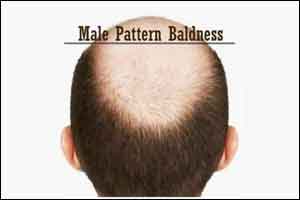- Home
- Editorial
- News
- Practice Guidelines
- Anesthesiology Guidelines
- Cancer Guidelines
- Cardiac Sciences Guidelines
- Critical Care Guidelines
- Dentistry Guidelines
- Dermatology Guidelines
- Diabetes and Endo Guidelines
- Diagnostics Guidelines
- ENT Guidelines
- Featured Practice Guidelines
- Gastroenterology Guidelines
- Geriatrics Guidelines
- Medicine Guidelines
- Nephrology Guidelines
- Neurosciences Guidelines
- Obs and Gynae Guidelines
- Ophthalmology Guidelines
- Orthopaedics Guidelines
- Paediatrics Guidelines
- Psychiatry Guidelines
- Pulmonology Guidelines
- Radiology Guidelines
- Surgery Guidelines
- Urology Guidelines
Male-pattern baldness and premature graying associated with risk of early heart disease

Male-pattern baldness and premature greying are associated with a more than fivefold risk of heart disease before the age of 40 years, according to research presented at the 69th Annual Conference of the Cardiological Society of India (CSI). Obesity was associated with a fourfold risk of early heart disease.
The congress is being held in Kolkata, India, from 30 November to 3 December. Experts from the European Society of Cardiology (ESC) will present a special programme.1
"The incidence of coronary artery disease in young men is increasing but cannot be explained by traditional risk factors," said author Dr Sachin Patil, a third-year resident at the U.N. Mehta Institute of Cardiology and Research Centre, Ahmedabad, Gujarat, India. "Premature greying and androgenic alopecia (male-pattern baldness) correlate well with vascular age irrespective of chronological age and are plausible risk factors for coronary artery disease."
This study investigated the association of premature hair greying and alopecia patterns in young Indian men with coronary artery disease. The study included 790 men aged less than 40 years with coronary artery disease and 1 270 age-matched healthy men who acted as a control group.
All participants had a clinical history taken, electrocardiogram (ECG), echocardiography, blood tests, and coronary angiogram. Participants were given a male-pattern baldness score of 0 (none), 1 (mild), 2 (moderate), or 3 (severe) after analysis of 24 different views of the scalp. A hair whitening score was determined according to the percentage of grey/white hairs: 1: pure black; 2: black greater than white; 3: black equals white; 4: white greater than black; 5: pure white.
The researchers analysed the correlation between premature grey hair and alopecia with the complexity and severity of angiographic lesions (an indicator of coronary artery disease) and compared the results between the two groups.
The researchers found that young men with coronary artery disease had a higher prevalence of premature greying (50% versus 30%) and male-pattern baldness (49% versus 27%) compared to healthy controls. After adjusting for age and other cardiovascular risk factors, male-pattern baldness was associated with a 5.6 times greater risk of coronary artery disease (95% confidence interval [CI] 4.0-7.8, p<0.0001) and premature greying was associated with a 5.3 times greater risk (95% CI 3.7-7.5, p<0.0001).
Male-pattern baldness and premature greying were the strongest predictors of coronary artery disease in young Indian men followed by obesity, which was associated with a 4.1 times greater risk (95% CI 2.8-6.0, p<0.0001). Diabetes mellitus, hypertension, family history of premature coronary artery disease, central obesity, higher body mass index, dyslipidaemia and smoking were predictors of coronary artery disease but to a lesser extent than male-pattern baldness, premature greying, and obesity.
Principal investigator, Dr Kamal Sharma, associate professor, Department of Cardiology, U.N. Mehta Institute of Cardiology and Research Centre, said: "Baldness and premature greying should be considered risk factors for coronary artery disease. These factors may indicate biological, rather than chronological, age which may be important in determining total cardiovascular risk. Currently physicians use common sense to estimate biological age but a validated scale is needed."
Dr Dhammdeep Humane, lead author, senior cardiology resident, U.N. Mehta Institute of Cardiology and Research Centre, added: "Men with premature greying and androgenic alopecia should receive extra monitoring for coronary artery disease and advice on lifestyle changes such as healthy diet, exercise, and stress management. Our study found associations but a causal relationship needs to be established before statins can be recommended for men with baldness or premature greying."
Dr K. Sarat Chandra, CSI President-Elect, said: "It is an established fact that premature coronary artery disease is becoming more common in India with each passing day. We do not know the exact reasons behind this. The present study suggesting that premature greying and male-pattern baldness could be important risk factors goes a long way in our understanding of this riddle."
Professor Marco Roffi, course director of the ESC programme at CSI and head of the Interventional Cardiology Unit, Geneva University Hospital, Geneva, Switzerland, said: "Assessment of risk factors is critical in the prevention and management of cardiovascular disease. Classical risk factors such as diabetes, family history of coronary disease, smoking, sedentary lifestyle, high cholesterol levels and high blood pressure are responsible for the vast majority of cardiovascular disease. It remains to be determined whether potential new risk factors, like the ones described, may improve cardiovascular risk assessment."

Disclaimer: This site is primarily intended for healthcare professionals. Any content/information on this website does not replace the advice of medical and/or health professionals and should not be construed as medical/diagnostic advice/endorsement or prescription. Use of this site is subject to our terms of use, privacy policy, advertisement policy. © 2020 Minerva Medical Treatment Pvt Ltd